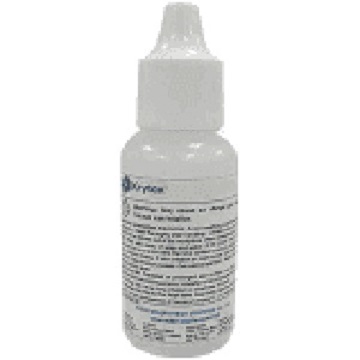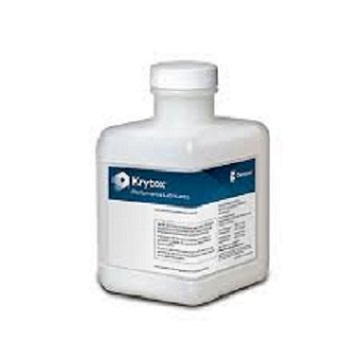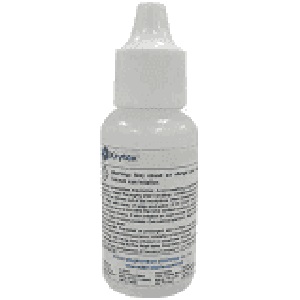Chemours Krytox GPL 107 Oil 2 oz Dropper Bottle
Description
Chemours Krytox GPL 107 Oil 2 oz Dropper Bottle
One of the greatest advantages of using Krytox GPL 107 oil is stability in a wide variety of operating conditions and environments. This inert nature is what allows Krytox oils and greases to outlast and outperform competing hydrocarbon products.
Standard Krytox lubricants contain only carbon, oxygen, and fluorine; whereas, hydrocarbons contain hydrogen. The absence of hydrogen greatly increases the stability of the lubricants and renders them nonflammable with no flash point. They will not burn or support combustion, even in an environment of 100% liquid or gaseous oxygen.
Krytox GPL 107 Oil is not only resistant to oxygen, but they are also inert to virtually all chemicals used in a variety of industries. They are insoluble in most solvents, but are soluble in highly fluorinated fluids and some super critical fluids, such as CO2.
At elevated temperatures and pressures, PFPE oils are highly resistant to attack by gaseous and liquid oxygen. As a result, Krytox oils and greases have become preferred lubricants in the oxygen manufacturing industry and in those industries that use oxygen.
Krytox lubricants do not react with gaseous oxygen under shock loading or with liquid oxygen (LOX), nitrogen tetroxide, or inhibited red fuming nitric acid in impact tests. LOX impact tests were conducted in accordance with ASTM D2512. Other impact tests conducted at 214 J/cm2 (200 ft·lb/in2), according to the method described in ASTM Bulletin 250, also showed no reaction. Krytox lubricants have also been evaluated and certified by the BAM Federal Institute for Materials Research and Testing in Germany for reactivity with gaseous and liquid oxygen under pressure. Table 4, “Oxygen Compatibility of Krytox Lubricants,” shows oxygen compatibility of Krytox lubricants.
Krytox GPL 107 oil is remarkably stable to radiation when compared with many materials used as lubricants or power fluids. Irradiation of Krytox lubricants causes minor depolymerization, with a consequent reduction in viscosity and formation of volatile products, but not solids or sludge. In one test exposure of a Krytox sample to an electron bombardment of 107 rad at ambient temperature in air resulted in a viscosity decrease of only 8%. The irradiated sample contained no sludge and was unchanged in appearance.
Advantages of Chemours Krytox GPL 107 Oil
- High Temperature Stability, up to 800°F / 426°C
- Wide Operating Range, from -103°F (-75°C) to greater than 800°F (426°C), compared with hydrocarbon lubricants with an operating range of 0°F (-18°C) to 210°F (98°C).
- Oxygen Compatibility, safe for oxygen service.
- Chemical Inertness. Insoluble in hydrocarbons, petroleum distillates, water, steam, chemical solvents and acids/bases. Provides extra protection against aggressive chemicals that degrade conventional lubricants.
- Ionizing Radiation Resistance, more stable than most hydrocarbon and synthetic materials.
- Compatible with plastics, elastomers, metals and ceramics.
- Extends Service Life of critical components. Reduces down time and maintenance costs.
- Low Vapor Pressure
- Low Outgassing
- Nonflammable
- Nontoxic
- No Migration, contains no silicones.
- Food Grades (H1 & H2)
- Aerospace Grades
- Mil-spec Grades
Krytox GPL Oil is available in 8 standard grades
| GPL Grade | 100 | 101 | 102 | 103 | 104 | 105 | 106 | 107 |
| Viscosity, cSt (20°C) | 7 | 16 | 36 | 80 | 180 | 550 | 810 | 1600 |
| Temp Range (°C) | < -70 to 66 | < -70 to 104 | -63 to 132 | -60 to 154 | -51 to 179 | -36 to 204 | -36 to 260 | -30 to 288 |
| Temp Range (°F) | < -94 to 150 | < -94 to 220 | -81 to 270 | -76 to 310 | -60 to 355 | -33 to 400 | -33 to 500 | -22 to 550 |
Applications of Chemours Krytox GPL 107 Oil
- O-Rings
- Fill Fluid
- Injection Molding
- Slip-Ring
- Mandrels
Product Information: Chemours Krytox-GPL Typical Properties
Chemours Krytox GPL Typical Properties Performance Lubricants
Additional information
| Weight | 1 lbs |
|---|---|
| Dimensions | 1 × 1 × 8 in |





